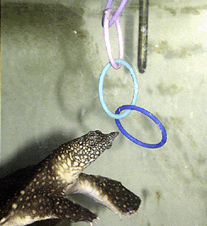Rack systems comprise a series of diminutive drawers or other shelved containers for stocking and breeding animals and have long been the preferred option for some of the husbandry cheapskates or mass-producers of critters (Figure 1): notably, culinary chickens, laboratory or feeder mice, rats, invertebrates and, for the pet industry, an array of small furries, birds, snakes, lizards, amphibians and fishes. To the nonchalant or the nonsensical, rack systems follow the minimalist mindset for keepers who wish to house – or hoard – large numbers of animals in very limited space. All of this is very convenient for the carer who does not care about an animal’s needs for roaming, habitat diversity, socialisation, general stimulation, control over environment and other essentials for good welfare.

Several scientific investigations highlight the stimulation-poor and deprived nature of rack systems, which not only imply depauperate lifestyles, but also directly promote acute and chronic stress
Unsurprisingly, within such conditions the welfare problems soon rack up. Indeed, several scientific investigations highlight the stimulation-poor and deprived nature of rack systems, which not only imply depauperate lifestyles, but also directly promote acute and chronic stress, as well as a raft of related harms, such as abnormal behaviours, co-occupant aggression, injury, infection, disease and death. For some animals, typically birds and small mammals, inherently high metabolic rates can quickly spell morbidity and disaster, whereas fishes, amphibians and reptiles can languish for weeks, months or years incarcerated in their cell-blocks of deprivation.
| Did you know we offer CPD membership plans? Get access to thousands more articles, hundreds of short courses and easily fulfil your annual CPD requirements. Find out more here. |
Shelf life
A broiler hen may be forced to occupy a battery cage with a floor space of just larger than an A4 sheet of paper during its maximum allowed life of only around 18 months, during which time approximately 4 to 7 percent may perish from stress, skin lesions, fractures and fights – pretty bad outcomes for a mere 72 weeks of life under supposedly “managed care”. At commercial pet suppliers and public-facing stores, the rack accommodation of choice for trading small furries and reptiles is often the “Tupperware-style” box. Each box is typically “furnished” with a piece of paper or some other absorbent substrate, a small water dish and a so-called hide – essentially anything from half a coconut shell to a clay pipe or a disused cardboard food box for crackers – not exactly the Ritz (Figure 2)! Few people would keep their lunch in such boxes for more than a few hours, but pet dealers and keepers are content to confine lizards and snakes for months or years.

Again unsurprisingly, rack systems have a very poor record for welfare, being closely implicated in the mortality rates among animals traded for pets of 5.5 percent for mammals, 41 percent for reptiles and 18 percent for invertebrates in just 10 days (Ashley et al., 2014). Rack life is hardly top-shelf. And it is not only scientists and vets who are concerned about rack systems; voices even from within the exotic pet community are also criticising rack systems as constituting poor and unethical practice. Indeed, in Australia and Germany legal challenges have been launched seeking to outlaw racks for the inhumane conditions they impose on animals. Rack system promoters should be racked with guilt.
Off-the-shelf animals with a poor shelf life
Rack systems clearly provide no place for animals to be normal, and whether in science, society or sensibility, there is no place for the animal rack system
Whether breeding, stocking or keeping animals for food, study or pets, if the purpose is to get something from these sentient beings, then – surely – the least one can do is afford them a life worth living. In rack systems, animals are – quite literally – off-the-shelf items, handled as if goods in a haberdashery department. From their already poor shelf life, very many will soon succumb, or go on to face further miserable lives in permanent cages the size of TV sets in people’s homes. Rack systems clearly provide no place for animals to be normal, and whether in science, society or sensibility, there is no place for the animal rack system.










